International Marketing Management Report: Felicetti Pasta Expansion
VerifiedAdded on 2020/01/07
|26
|5770
|300
Report
AI Summary
This report delves into the international marketing strategies for Felicetti, an Italian pasta manufacturer, focusing on its potential expansion into Japan and Malaysia. It begins with an overview of the Italian pasta industry and a company profile of Felicetti. The report then explores market analysis and research, including Porter's Five Forces model and risk analysis, to evaluate the attractiveness of each market. Customer preferences and market findings are presented, based on a research conducted in Japan. The report also covers market entry strategies and advertising approaches, with pro and con statements. The report concludes with recommendations, and an advertising strategy, along with segmentation and targeting considerations. This comprehensive analysis aims to provide insights into the factors crucial for Felicetti's successful international venture, enabling the company to make informed decisions and achieve its desired growth in new regions.

International Marketing
Management
1
Management
1
Paraphrase This Document
Need a fresh take? Get an instant paraphrase of this document with our AI Paraphraser
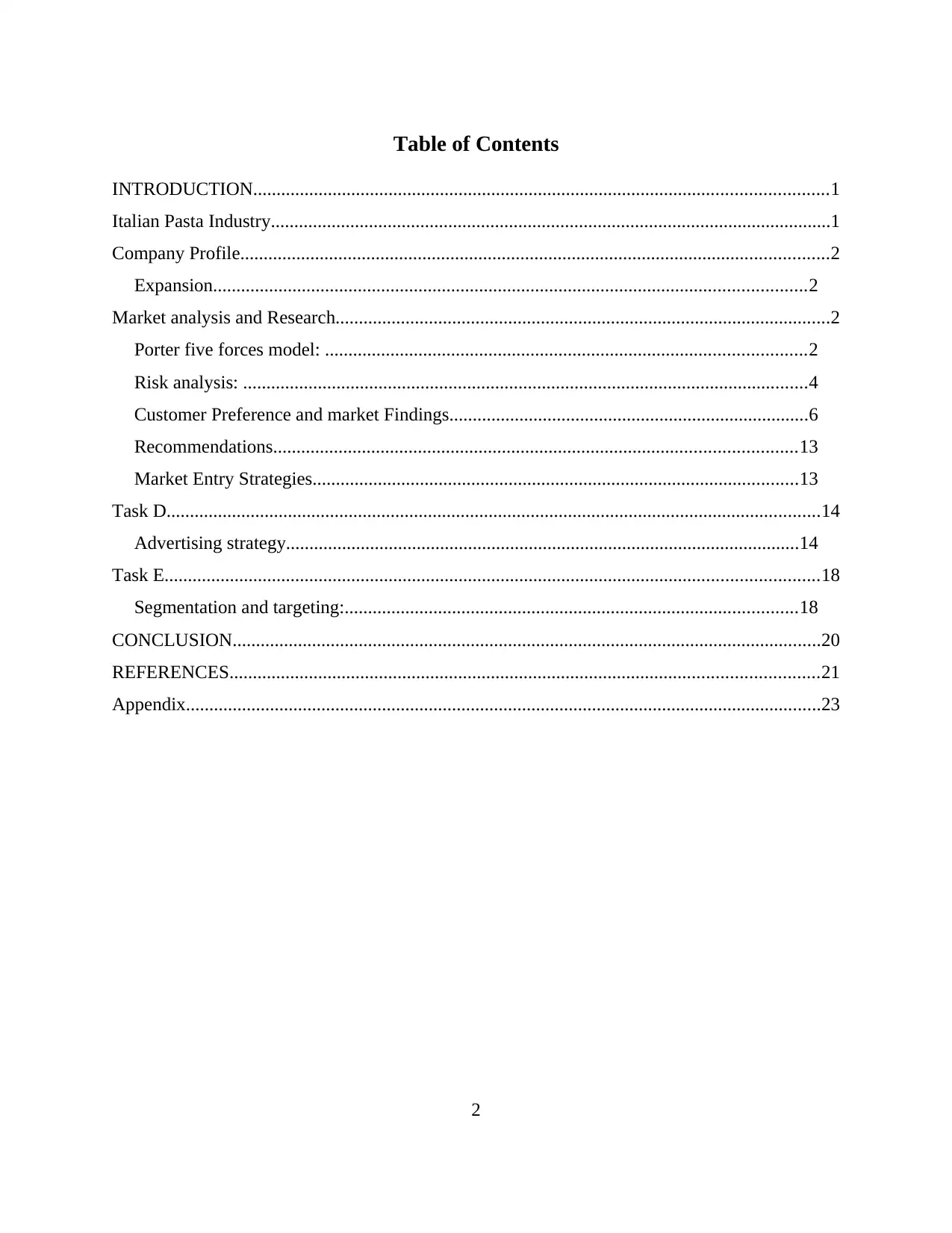
Table of Contents
INTRODUCTION...........................................................................................................................1
Italian Pasta Industry........................................................................................................................1
Company Profile..............................................................................................................................2
Expansion...............................................................................................................................2
Market analysis and Research..........................................................................................................2
Porter five forces model: .......................................................................................................2
Risk analysis: .........................................................................................................................4
Customer Preference and market Findings.............................................................................6
Recommendations................................................................................................................13
Market Entry Strategies........................................................................................................13
Task D............................................................................................................................................14
Advertising strategy..............................................................................................................14
Task E............................................................................................................................................18
Segmentation and targeting:.................................................................................................18
CONCLUSION..............................................................................................................................20
REFERENCES..............................................................................................................................21
Appendix........................................................................................................................................23
2
INTRODUCTION...........................................................................................................................1
Italian Pasta Industry........................................................................................................................1
Company Profile..............................................................................................................................2
Expansion...............................................................................................................................2
Market analysis and Research..........................................................................................................2
Porter five forces model: .......................................................................................................2
Risk analysis: .........................................................................................................................4
Customer Preference and market Findings.............................................................................6
Recommendations................................................................................................................13
Market Entry Strategies........................................................................................................13
Task D............................................................................................................................................14
Advertising strategy..............................................................................................................14
Task E............................................................................................................................................18
Segmentation and targeting:.................................................................................................18
CONCLUSION..............................................................................................................................20
REFERENCES..............................................................................................................................21
Appendix........................................................................................................................................23
2
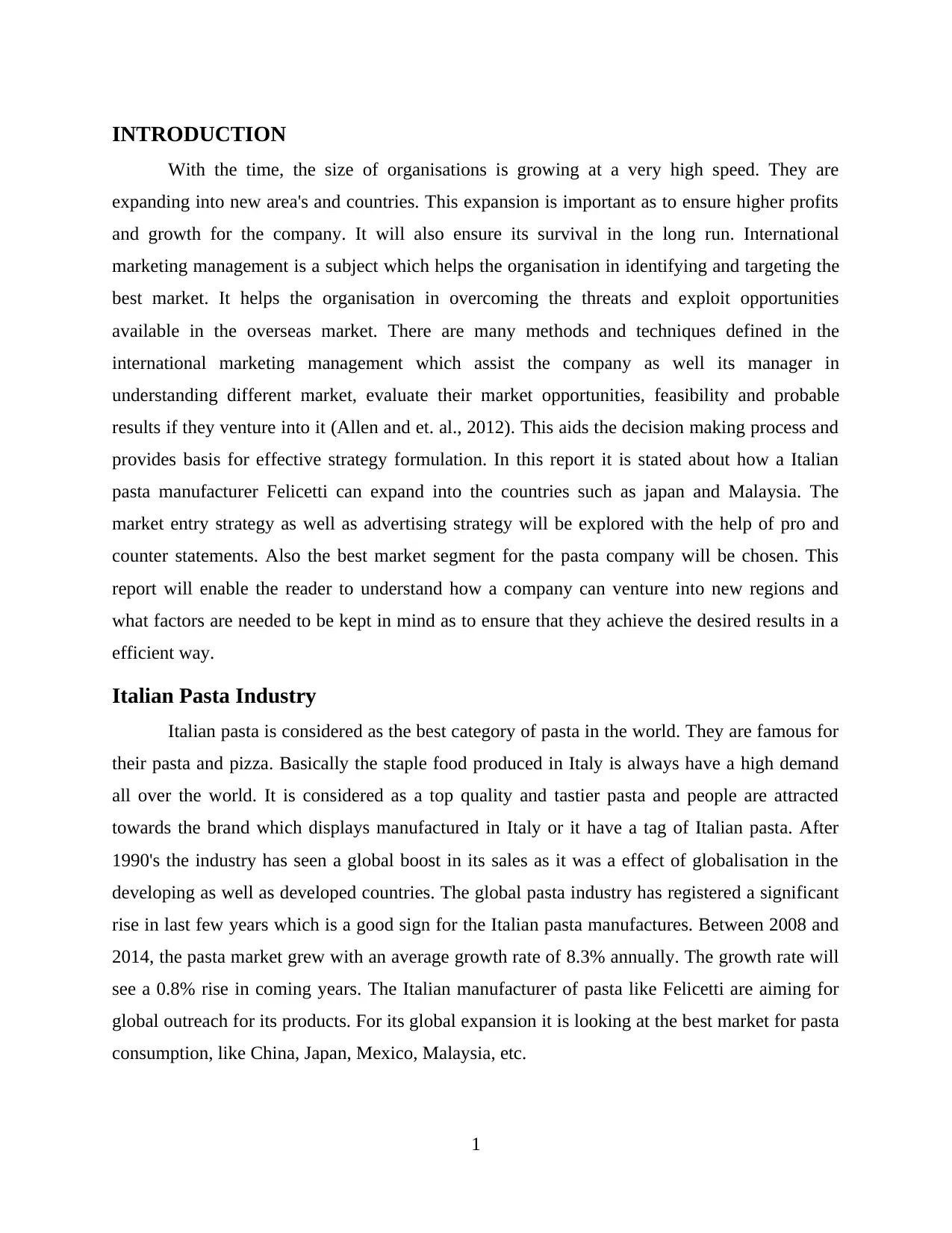
INTRODUCTION
With the time, the size of organisations is growing at a very high speed. They are
expanding into new area's and countries. This expansion is important as to ensure higher profits
and growth for the company. It will also ensure its survival in the long run. International
marketing management is a subject which helps the organisation in identifying and targeting the
best market. It helps the organisation in overcoming the threats and exploit opportunities
available in the overseas market. There are many methods and techniques defined in the
international marketing management which assist the company as well its manager in
understanding different market, evaluate their market opportunities, feasibility and probable
results if they venture into it (Allen and et. al., 2012). This aids the decision making process and
provides basis for effective strategy formulation. In this report it is stated about how a Italian
pasta manufacturer Felicetti can expand into the countries such as japan and Malaysia. The
market entry strategy as well as advertising strategy will be explored with the help of pro and
counter statements. Also the best market segment for the pasta company will be chosen. This
report will enable the reader to understand how a company can venture into new regions and
what factors are needed to be kept in mind as to ensure that they achieve the desired results in a
efficient way.
Italian Pasta Industry
Italian pasta is considered as the best category of pasta in the world. They are famous for
their pasta and pizza. Basically the staple food produced in Italy is always have a high demand
all over the world. It is considered as a top quality and tastier pasta and people are attracted
towards the brand which displays manufactured in Italy or it have a tag of Italian pasta. After
1990's the industry has seen a global boost in its sales as it was a effect of globalisation in the
developing as well as developed countries. The global pasta industry has registered a significant
rise in last few years which is a good sign for the Italian pasta manufactures. Between 2008 and
2014, the pasta market grew with an average growth rate of 8.3% annually. The growth rate will
see a 0.8% rise in coming years. The Italian manufacturer of pasta like Felicetti are aiming for
global outreach for its products. For its global expansion it is looking at the best market for pasta
consumption, like China, Japan, Mexico, Malaysia, etc.
1
With the time, the size of organisations is growing at a very high speed. They are
expanding into new area's and countries. This expansion is important as to ensure higher profits
and growth for the company. It will also ensure its survival in the long run. International
marketing management is a subject which helps the organisation in identifying and targeting the
best market. It helps the organisation in overcoming the threats and exploit opportunities
available in the overseas market. There are many methods and techniques defined in the
international marketing management which assist the company as well its manager in
understanding different market, evaluate their market opportunities, feasibility and probable
results if they venture into it (Allen and et. al., 2012). This aids the decision making process and
provides basis for effective strategy formulation. In this report it is stated about how a Italian
pasta manufacturer Felicetti can expand into the countries such as japan and Malaysia. The
market entry strategy as well as advertising strategy will be explored with the help of pro and
counter statements. Also the best market segment for the pasta company will be chosen. This
report will enable the reader to understand how a company can venture into new regions and
what factors are needed to be kept in mind as to ensure that they achieve the desired results in a
efficient way.
Italian Pasta Industry
Italian pasta is considered as the best category of pasta in the world. They are famous for
their pasta and pizza. Basically the staple food produced in Italy is always have a high demand
all over the world. It is considered as a top quality and tastier pasta and people are attracted
towards the brand which displays manufactured in Italy or it have a tag of Italian pasta. After
1990's the industry has seen a global boost in its sales as it was a effect of globalisation in the
developing as well as developed countries. The global pasta industry has registered a significant
rise in last few years which is a good sign for the Italian pasta manufactures. Between 2008 and
2014, the pasta market grew with an average growth rate of 8.3% annually. The growth rate will
see a 0.8% rise in coming years. The Italian manufacturer of pasta like Felicetti are aiming for
global outreach for its products. For its global expansion it is looking at the best market for pasta
consumption, like China, Japan, Mexico, Malaysia, etc.
1
⊘ This is a preview!⊘
Do you want full access?
Subscribe today to unlock all pages.

Trusted by 1+ million students worldwide
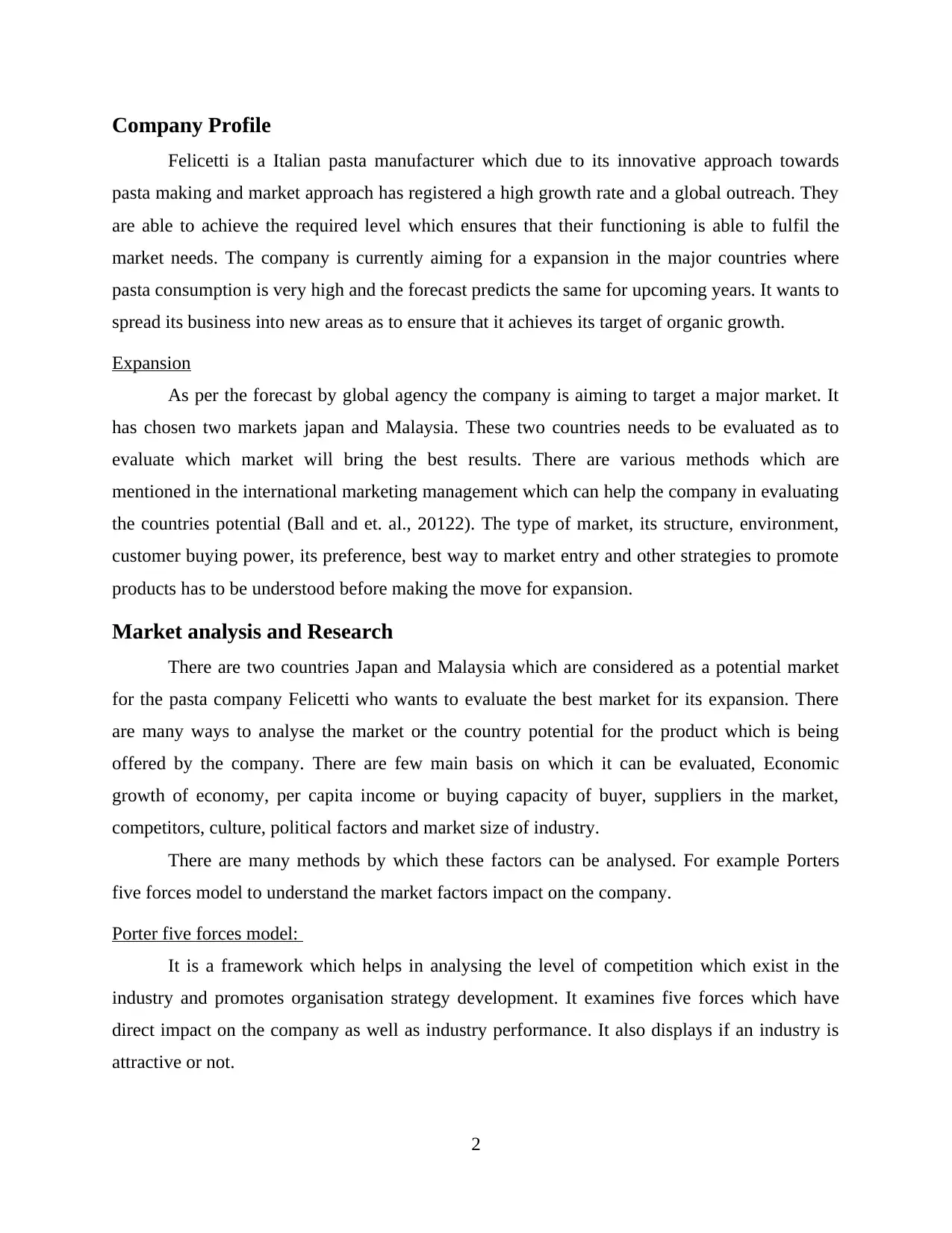
Company Profile
Felicetti is a Italian pasta manufacturer which due to its innovative approach towards
pasta making and market approach has registered a high growth rate and a global outreach. They
are able to achieve the required level which ensures that their functioning is able to fulfil the
market needs. The company is currently aiming for a expansion in the major countries where
pasta consumption is very high and the forecast predicts the same for upcoming years. It wants to
spread its business into new areas as to ensure that it achieves its target of organic growth.
Expansion
As per the forecast by global agency the company is aiming to target a major market. It
has chosen two markets japan and Malaysia. These two countries needs to be evaluated as to
evaluate which market will bring the best results. There are various methods which are
mentioned in the international marketing management which can help the company in evaluating
the countries potential (Ball and et. al., 20122). The type of market, its structure, environment,
customer buying power, its preference, best way to market entry and other strategies to promote
products has to be understood before making the move for expansion.
Market analysis and Research
There are two countries Japan and Malaysia which are considered as a potential market
for the pasta company Felicetti who wants to evaluate the best market for its expansion. There
are many ways to analyse the market or the country potential for the product which is being
offered by the company. There are few main basis on which it can be evaluated, Economic
growth of economy, per capita income or buying capacity of buyer, suppliers in the market,
competitors, culture, political factors and market size of industry.
There are many methods by which these factors can be analysed. For example Porters
five forces model to understand the market factors impact on the company.
Porter five forces model:
It is a framework which helps in analysing the level of competition which exist in the
industry and promotes organisation strategy development. It examines five forces which have
direct impact on the company as well as industry performance. It also displays if an industry is
attractive or not.
2
Felicetti is a Italian pasta manufacturer which due to its innovative approach towards
pasta making and market approach has registered a high growth rate and a global outreach. They
are able to achieve the required level which ensures that their functioning is able to fulfil the
market needs. The company is currently aiming for a expansion in the major countries where
pasta consumption is very high and the forecast predicts the same for upcoming years. It wants to
spread its business into new areas as to ensure that it achieves its target of organic growth.
Expansion
As per the forecast by global agency the company is aiming to target a major market. It
has chosen two markets japan and Malaysia. These two countries needs to be evaluated as to
evaluate which market will bring the best results. There are various methods which are
mentioned in the international marketing management which can help the company in evaluating
the countries potential (Ball and et. al., 20122). The type of market, its structure, environment,
customer buying power, its preference, best way to market entry and other strategies to promote
products has to be understood before making the move for expansion.
Market analysis and Research
There are two countries Japan and Malaysia which are considered as a potential market
for the pasta company Felicetti who wants to evaluate the best market for its expansion. There
are many ways to analyse the market or the country potential for the product which is being
offered by the company. There are few main basis on which it can be evaluated, Economic
growth of economy, per capita income or buying capacity of buyer, suppliers in the market,
competitors, culture, political factors and market size of industry.
There are many methods by which these factors can be analysed. For example Porters
five forces model to understand the market factors impact on the company.
Porter five forces model:
It is a framework which helps in analysing the level of competition which exist in the
industry and promotes organisation strategy development. It examines five forces which have
direct impact on the company as well as industry performance. It also displays if an industry is
attractive or not.
2
Paraphrase This Document
Need a fresh take? Get an instant paraphrase of this document with our AI Paraphraser
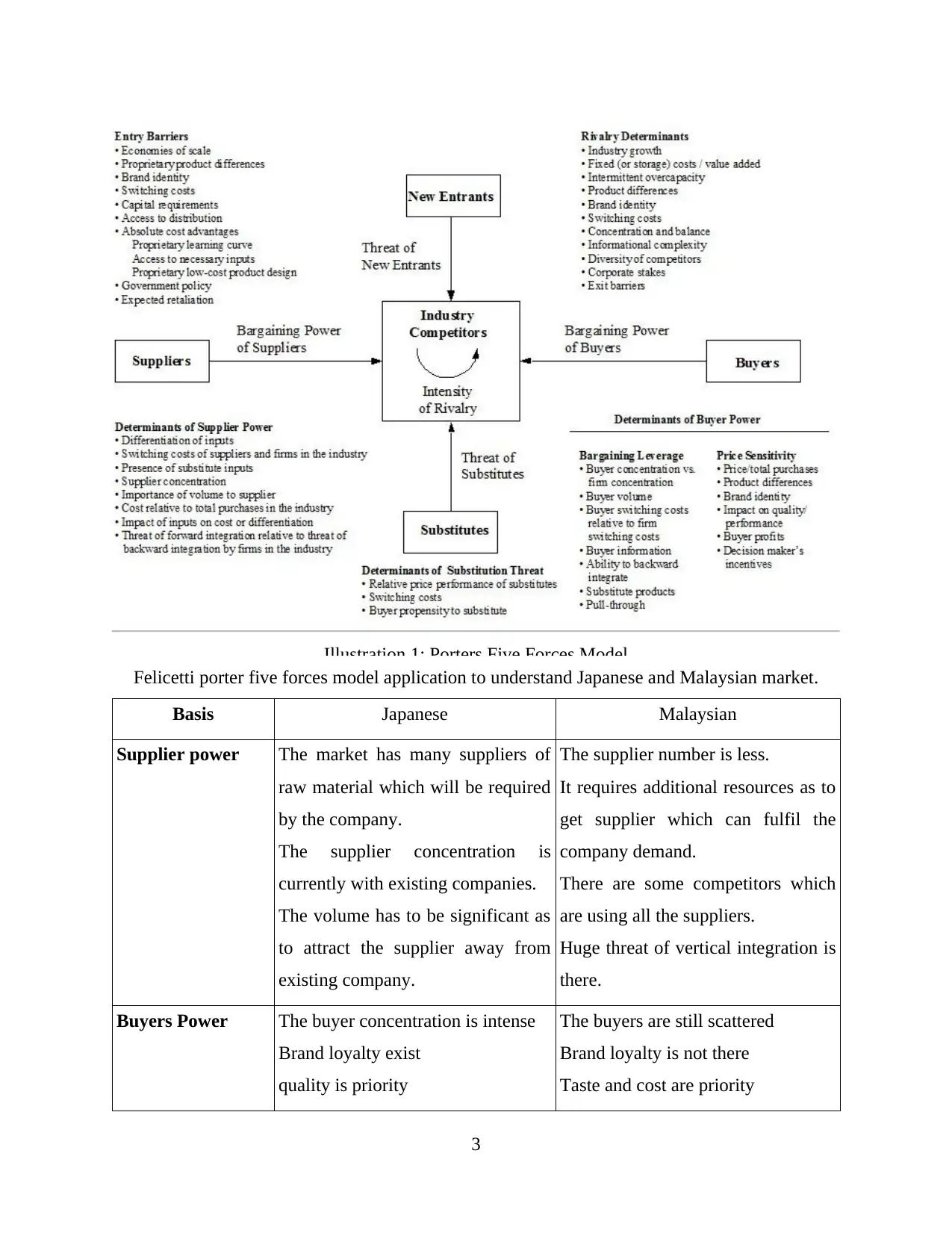
Felicetti porter five forces model application to understand Japanese and Malaysian market.
Basis Japanese Malaysian
Supplier power The market has many suppliers of
raw material which will be required
by the company.
The supplier concentration is
currently with existing companies.
The volume has to be significant as
to attract the supplier away from
existing company.
The supplier number is less.
It requires additional resources as to
get supplier which can fulfil the
company demand.
There are some competitors which
are using all the suppliers.
Huge threat of vertical integration is
there.
Buyers Power The buyer concentration is intense
Brand loyalty exist
quality is priority
The buyers are still scattered
Brand loyalty is not there
Taste and cost are priority
3
Illustration 1: Porters Five Forces Model
Basis Japanese Malaysian
Supplier power The market has many suppliers of
raw material which will be required
by the company.
The supplier concentration is
currently with existing companies.
The volume has to be significant as
to attract the supplier away from
existing company.
The supplier number is less.
It requires additional resources as to
get supplier which can fulfil the
company demand.
There are some competitors which
are using all the suppliers.
Huge threat of vertical integration is
there.
Buyers Power The buyer concentration is intense
Brand loyalty exist
quality is priority
The buyers are still scattered
Brand loyalty is not there
Taste and cost are priority
3
Illustration 1: Porters Five Forces Model
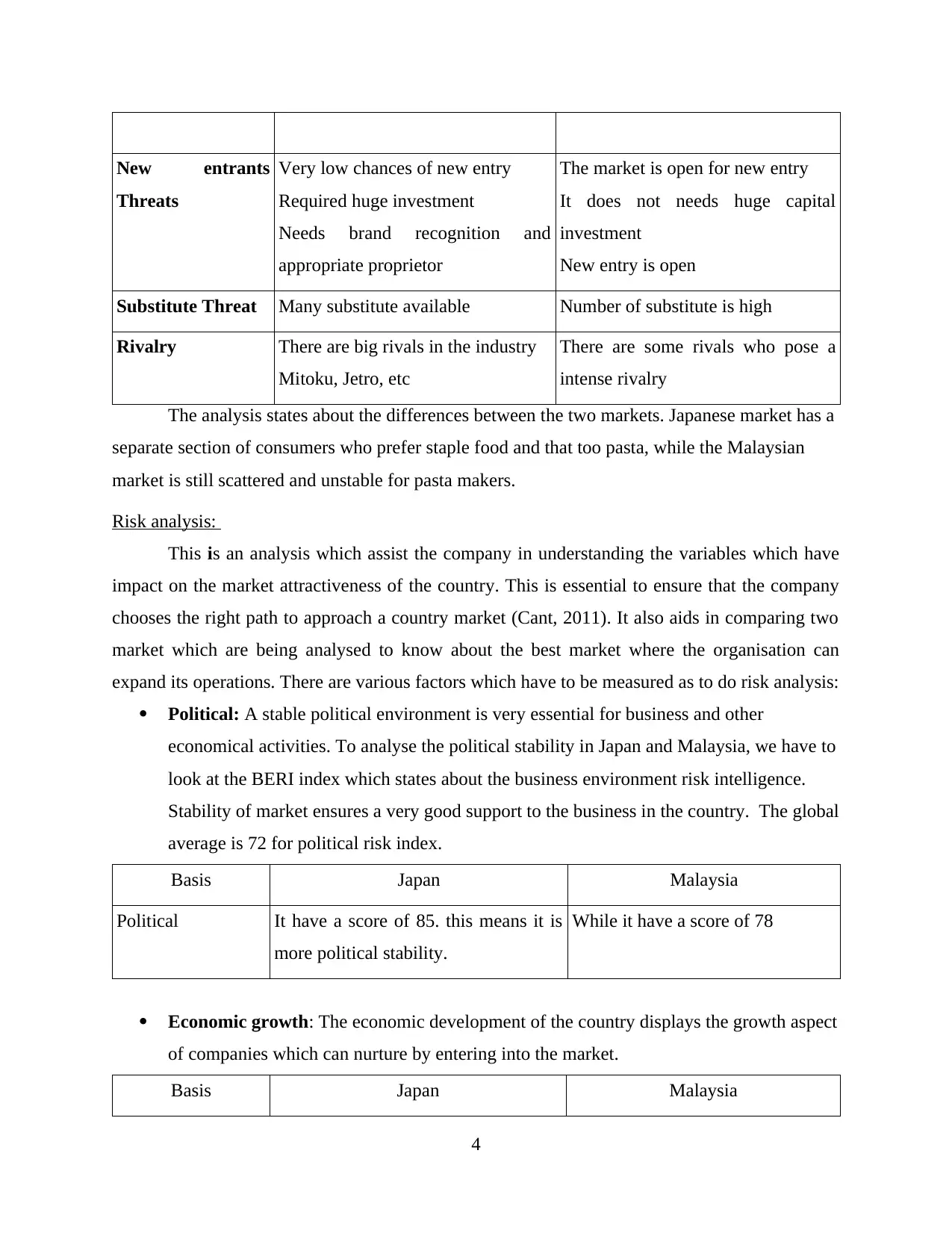
New entrants
Threats
Very low chances of new entry
Required huge investment
Needs brand recognition and
appropriate proprietor
The market is open for new entry
It does not needs huge capital
investment
New entry is open
Substitute Threat Many substitute available Number of substitute is high
Rivalry There are big rivals in the industry
Mitoku, Jetro, etc
There are some rivals who pose a
intense rivalry
The analysis states about the differences between the two markets. Japanese market has a
separate section of consumers who prefer staple food and that too pasta, while the Malaysian
market is still scattered and unstable for pasta makers.
Risk analysis:
This is an analysis which assist the company in understanding the variables which have
impact on the market attractiveness of the country. This is essential to ensure that the company
chooses the right path to approach a country market (Cant, 2011). It also aids in comparing two
market which are being analysed to know about the best market where the organisation can
expand its operations. There are various factors which have to be measured as to do risk analysis:
Political: A stable political environment is very essential for business and other
economical activities. To analyse the political stability in Japan and Malaysia, we have to
look at the BERI index which states about the business environment risk intelligence.
Stability of market ensures a very good support to the business in the country. The global
average is 72 for political risk index.
Basis Japan Malaysia
Political It have a score of 85. this means it is
more political stability.
While it have a score of 78
Economic growth: The economic development of the country displays the growth aspect
of companies which can nurture by entering into the market.
Basis Japan Malaysia
4
Threats
Very low chances of new entry
Required huge investment
Needs brand recognition and
appropriate proprietor
The market is open for new entry
It does not needs huge capital
investment
New entry is open
Substitute Threat Many substitute available Number of substitute is high
Rivalry There are big rivals in the industry
Mitoku, Jetro, etc
There are some rivals who pose a
intense rivalry
The analysis states about the differences between the two markets. Japanese market has a
separate section of consumers who prefer staple food and that too pasta, while the Malaysian
market is still scattered and unstable for pasta makers.
Risk analysis:
This is an analysis which assist the company in understanding the variables which have
impact on the market attractiveness of the country. This is essential to ensure that the company
chooses the right path to approach a country market (Cant, 2011). It also aids in comparing two
market which are being analysed to know about the best market where the organisation can
expand its operations. There are various factors which have to be measured as to do risk analysis:
Political: A stable political environment is very essential for business and other
economical activities. To analyse the political stability in Japan and Malaysia, we have to
look at the BERI index which states about the business environment risk intelligence.
Stability of market ensures a very good support to the business in the country. The global
average is 72 for political risk index.
Basis Japan Malaysia
Political It have a score of 85. this means it is
more political stability.
While it have a score of 78
Economic growth: The economic development of the country displays the growth aspect
of companies which can nurture by entering into the market.
Basis Japan Malaysia
4
⊘ This is a preview!⊘
Do you want full access?
Subscribe today to unlock all pages.

Trusted by 1+ million students worldwide
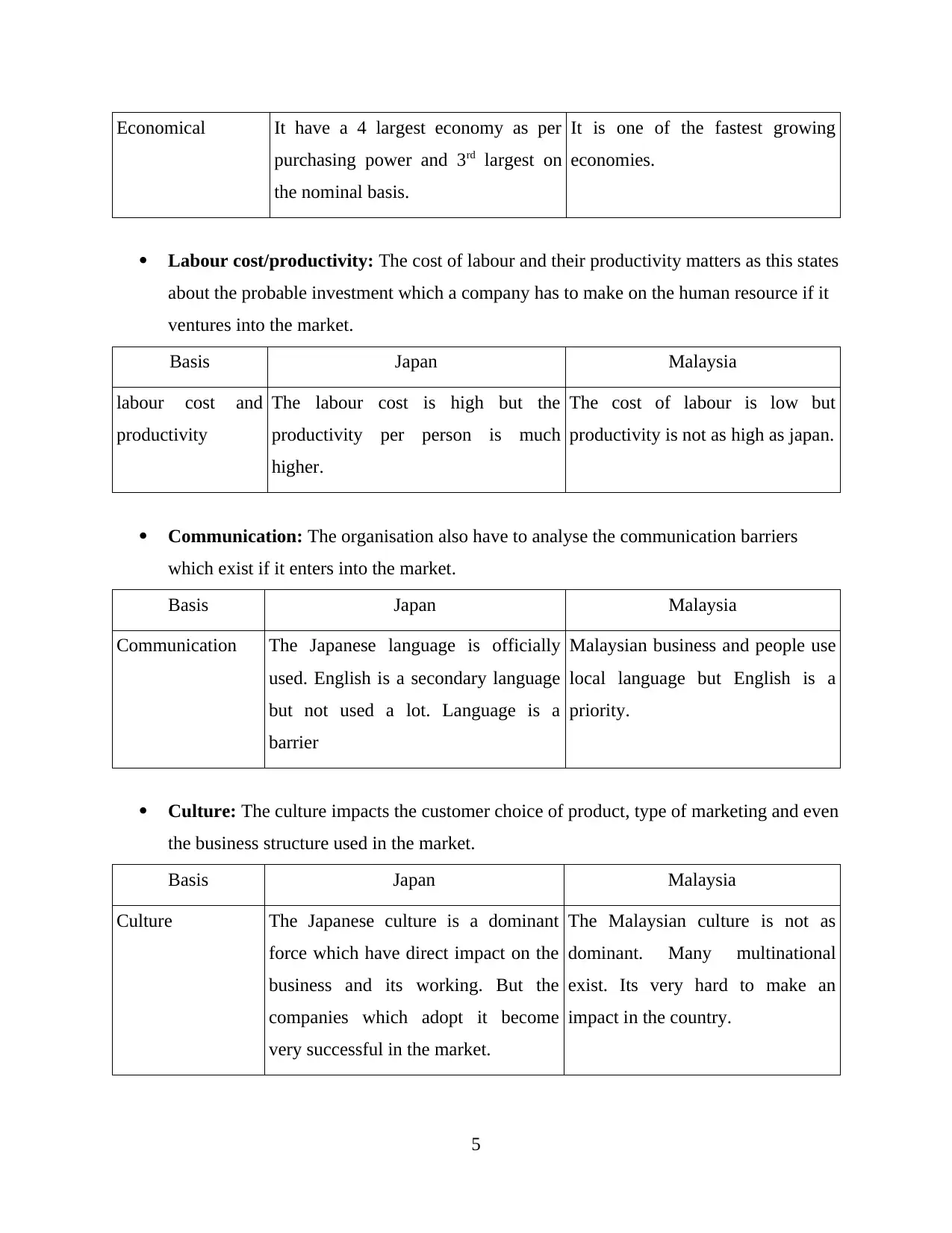
Economical It have a 4 largest economy as per
purchasing power and 3rd largest on
the nominal basis.
It is one of the fastest growing
economies.
Labour cost/productivity: The cost of labour and their productivity matters as this states
about the probable investment which a company has to make on the human resource if it
ventures into the market.
Basis Japan Malaysia
labour cost and
productivity
The labour cost is high but the
productivity per person is much
higher.
The cost of labour is low but
productivity is not as high as japan.
Communication: The organisation also have to analyse the communication barriers
which exist if it enters into the market.
Basis Japan Malaysia
Communication The Japanese language is officially
used. English is a secondary language
but not used a lot. Language is a
barrier
Malaysian business and people use
local language but English is a
priority.
Culture: The culture impacts the customer choice of product, type of marketing and even
the business structure used in the market.
Basis Japan Malaysia
Culture The Japanese culture is a dominant
force which have direct impact on the
business and its working. But the
companies which adopt it become
very successful in the market.
The Malaysian culture is not as
dominant. Many multinational
exist. Its very hard to make an
impact in the country.
5
purchasing power and 3rd largest on
the nominal basis.
It is one of the fastest growing
economies.
Labour cost/productivity: The cost of labour and their productivity matters as this states
about the probable investment which a company has to make on the human resource if it
ventures into the market.
Basis Japan Malaysia
labour cost and
productivity
The labour cost is high but the
productivity per person is much
higher.
The cost of labour is low but
productivity is not as high as japan.
Communication: The organisation also have to analyse the communication barriers
which exist if it enters into the market.
Basis Japan Malaysia
Communication The Japanese language is officially
used. English is a secondary language
but not used a lot. Language is a
barrier
Malaysian business and people use
local language but English is a
priority.
Culture: The culture impacts the customer choice of product, type of marketing and even
the business structure used in the market.
Basis Japan Malaysia
Culture The Japanese culture is a dominant
force which have direct impact on the
business and its working. But the
companies which adopt it become
very successful in the market.
The Malaysian culture is not as
dominant. Many multinational
exist. Its very hard to make an
impact in the country.
5
Paraphrase This Document
Need a fresh take? Get an instant paraphrase of this document with our AI Paraphraser
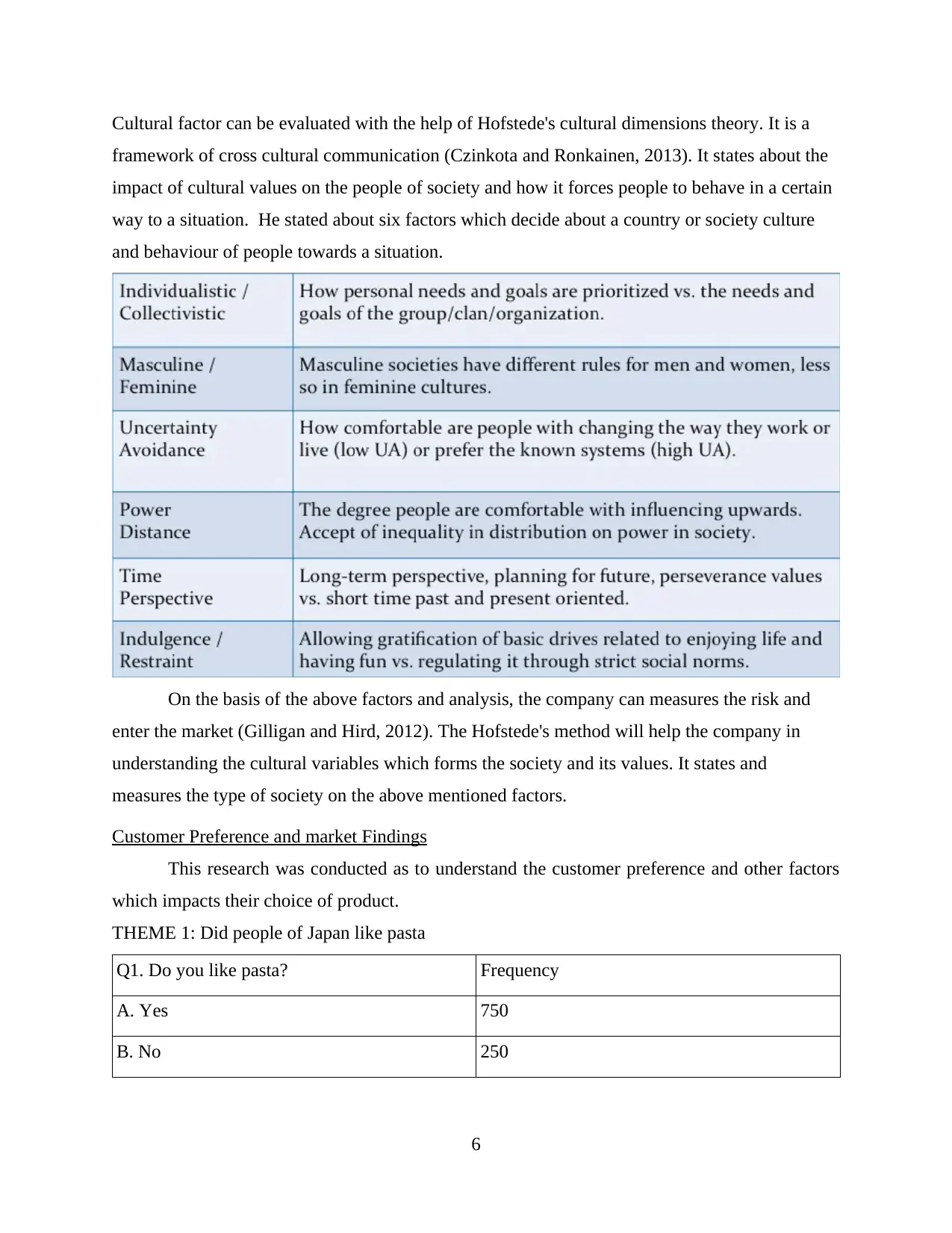
Cultural factor can be evaluated with the help of Hofstede's cultural dimensions theory. It is a
framework of cross cultural communication (Czinkota and Ronkainen, 2013). It states about the
impact of cultural values on the people of society and how it forces people to behave in a certain
way to a situation. He stated about six factors which decide about a country or society culture
and behaviour of people towards a situation.
On the basis of the above factors and analysis, the company can measures the risk and
enter the market (Gilligan and Hird, 2012). The Hofstede's method will help the company in
understanding the cultural variables which forms the society and its values. It states and
measures the type of society on the above mentioned factors.
Customer Preference and market Findings
This research was conducted as to understand the customer preference and other factors
which impacts their choice of product.
THEME 1: Did people of Japan like pasta
Q1. Do you like pasta? Frequency
A. Yes 750
B. No 250
6
framework of cross cultural communication (Czinkota and Ronkainen, 2013). It states about the
impact of cultural values on the people of society and how it forces people to behave in a certain
way to a situation. He stated about six factors which decide about a country or society culture
and behaviour of people towards a situation.
On the basis of the above factors and analysis, the company can measures the risk and
enter the market (Gilligan and Hird, 2012). The Hofstede's method will help the company in
understanding the cultural variables which forms the society and its values. It states and
measures the type of society on the above mentioned factors.
Customer Preference and market Findings
This research was conducted as to understand the customer preference and other factors
which impacts their choice of product.
THEME 1: Did people of Japan like pasta
Q1. Do you like pasta? Frequency
A. Yes 750
B. No 250
6
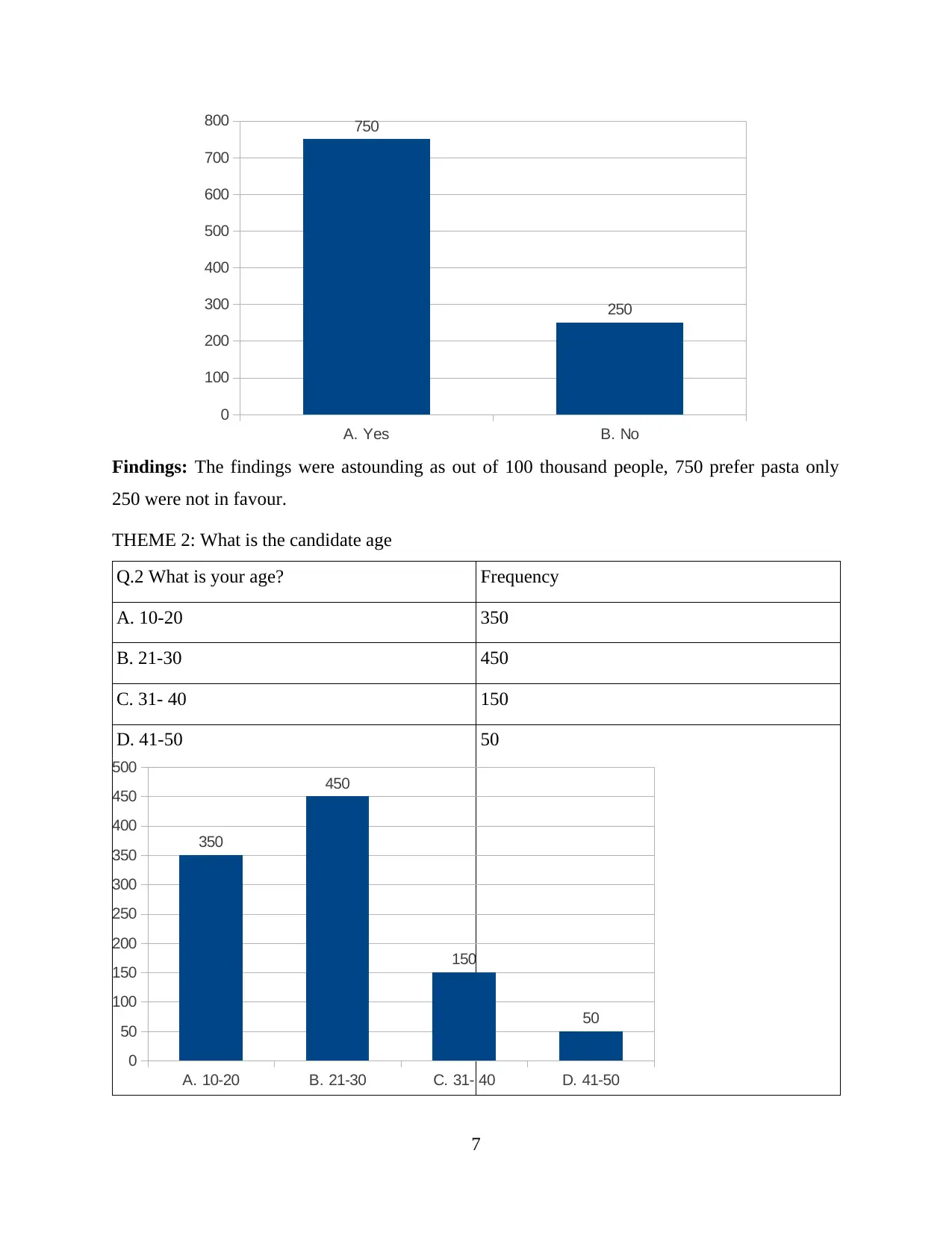
Findings: The findings were astounding as out of 100 thousand people, 750 prefer pasta only
250 were not in favour.
THEME 2: What is the candidate age
Q.2 What is your age? Frequency
A. 10-20 350
B. 21-30 450
C. 31- 40 150
D. 41-50 50
7
A. 10-20 B. 21-30 C. 31- 40 D. 41-50
0
50
100
150
200
250
300
350
400
450
500
350
450
150
50
A. Yes B. No
0
100
200
300
400
500
600
700
800 750
250
250 were not in favour.
THEME 2: What is the candidate age
Q.2 What is your age? Frequency
A. 10-20 350
B. 21-30 450
C. 31- 40 150
D. 41-50 50
7
A. 10-20 B. 21-30 C. 31- 40 D. 41-50
0
50
100
150
200
250
300
350
400
450
500
350
450
150
50
A. Yes B. No
0
100
200
300
400
500
600
700
800 750
250
⊘ This is a preview!⊘
Do you want full access?
Subscribe today to unlock all pages.

Trusted by 1+ million students worldwide
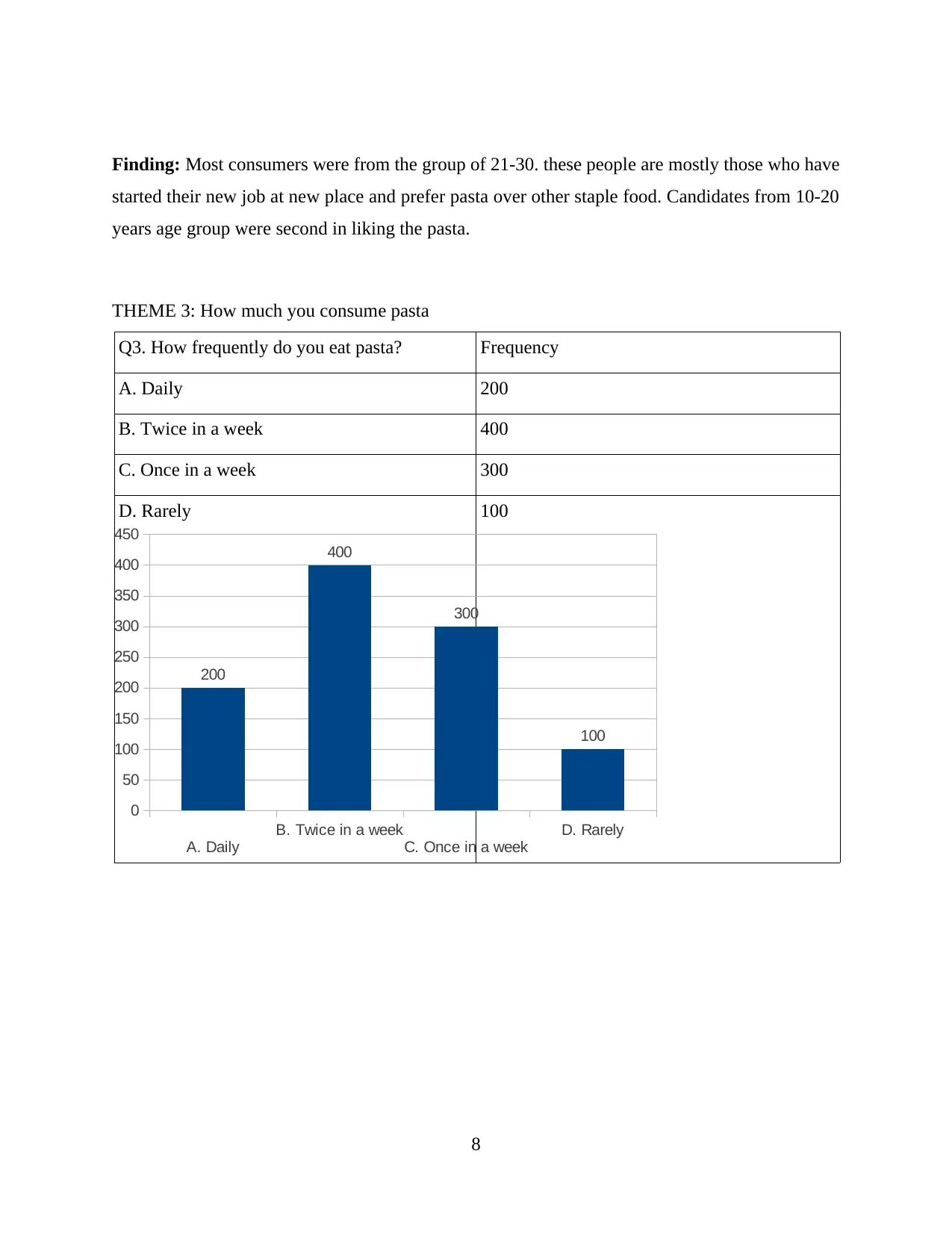
Finding: Most consumers were from the group of 21-30. these people are mostly those who have
started their new job at new place and prefer pasta over other staple food. Candidates from 10-20
years age group were second in liking the pasta.
THEME 3: How much you consume pasta
Q3. How frequently do you eat pasta? Frequency
A. Daily 200
B. Twice in a week 400
C. Once in a week 300
D. Rarely 100
8
A. Daily
B. Twice in a week
C. Once in a week
D. Rarely
0
50
100
150
200
250
300
350
400
450
200
400
300
100
started their new job at new place and prefer pasta over other staple food. Candidates from 10-20
years age group were second in liking the pasta.
THEME 3: How much you consume pasta
Q3. How frequently do you eat pasta? Frequency
A. Daily 200
B. Twice in a week 400
C. Once in a week 300
D. Rarely 100
8
A. Daily
B. Twice in a week
C. Once in a week
D. Rarely
0
50
100
150
200
250
300
350
400
450
200
400
300
100
Paraphrase This Document
Need a fresh take? Get an instant paraphrase of this document with our AI Paraphraser
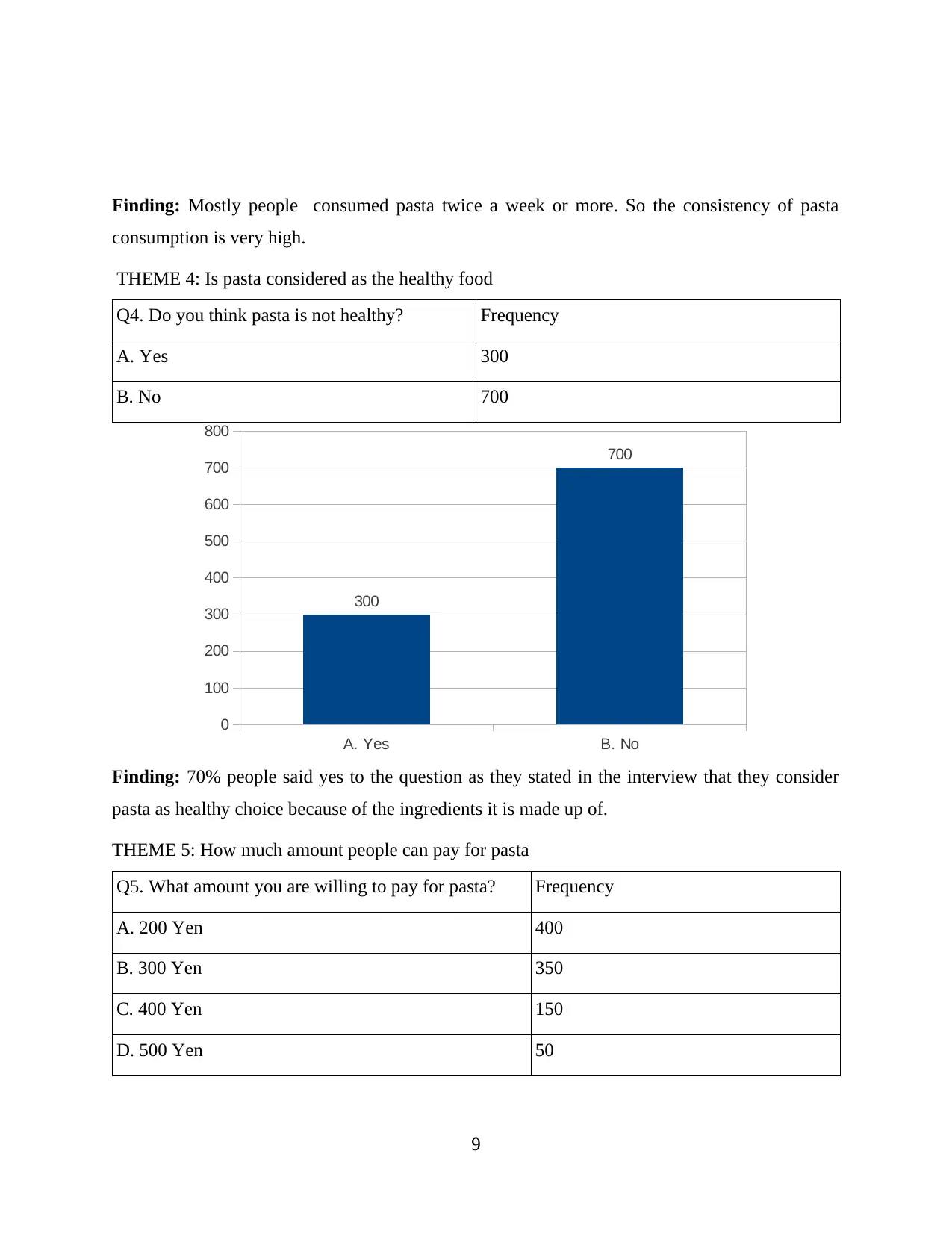
Finding: Mostly people consumed pasta twice a week or more. So the consistency of pasta
consumption is very high.
THEME 4: Is pasta considered as the healthy food
Q4. Do you think pasta is not healthy? Frequency
A. Yes 300
B. No 700
Finding: 70% people said yes to the question as they stated in the interview that they consider
pasta as healthy choice because of the ingredients it is made up of.
THEME 5: How much amount people can pay for pasta
Q5. What amount you are willing to pay for pasta? Frequency
A. 200 Yen 400
B. 300 Yen 350
C. 400 Yen 150
D. 500 Yen 50
9
A. Yes B. No
0
100
200
300
400
500
600
700
800
300
700
consumption is very high.
THEME 4: Is pasta considered as the healthy food
Q4. Do you think pasta is not healthy? Frequency
A. Yes 300
B. No 700
Finding: 70% people said yes to the question as they stated in the interview that they consider
pasta as healthy choice because of the ingredients it is made up of.
THEME 5: How much amount people can pay for pasta
Q5. What amount you are willing to pay for pasta? Frequency
A. 200 Yen 400
B. 300 Yen 350
C. 400 Yen 150
D. 500 Yen 50
9
A. Yes B. No
0
100
200
300
400
500
600
700
800
300
700
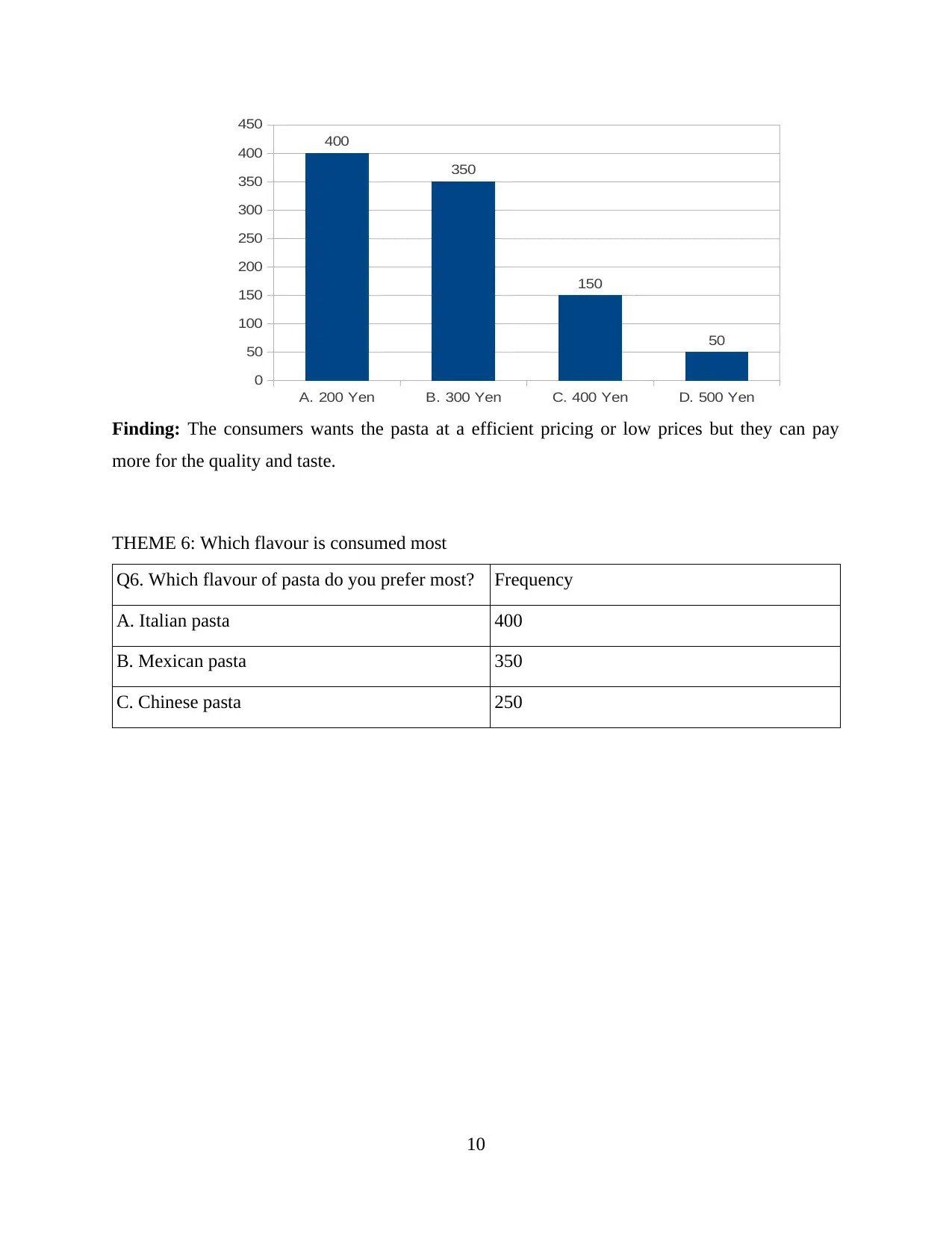
Finding: The consumers wants the pasta at a efficient pricing or low prices but they can pay
more for the quality and taste.
THEME 6: Which flavour is consumed most
Q6. Which flavour of pasta do you prefer most? Frequency
A. Italian pasta 400
B. Mexican pasta 350
C. Chinese pasta 250
10
A. 200 Yen B. 300 Yen C. 400 Yen D. 500 Yen
0
50
100
150
200
250
300
350
400
450
400
350
150
50
more for the quality and taste.
THEME 6: Which flavour is consumed most
Q6. Which flavour of pasta do you prefer most? Frequency
A. Italian pasta 400
B. Mexican pasta 350
C. Chinese pasta 250
10
A. 200 Yen B. 300 Yen C. 400 Yen D. 500 Yen
0
50
100
150
200
250
300
350
400
450
400
350
150
50
⊘ This is a preview!⊘
Do you want full access?
Subscribe today to unlock all pages.

Trusted by 1+ million students worldwide
1 out of 26
Related Documents
Your All-in-One AI-Powered Toolkit for Academic Success.
+13062052269
info@desklib.com
Available 24*7 on WhatsApp / Email
![[object Object]](/_next/static/media/star-bottom.7253800d.svg)
Unlock your academic potential
Copyright © 2020–2025 A2Z Services. All Rights Reserved. Developed and managed by ZUCOL.





